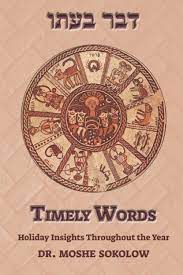
Reviewing: “Timely Words, Holiday Insights throughout the Year” by Dr. Moshe Sokolow. Kodesh Press. 2022. English. Paperback. 210 pages. ISBN-13: 978-1947857872.
In “Timely Words, Holiday Insights throughout the Year,” Dr. Moshe Sokolow provides timely insights for different periods throughout the year. Although this book provides topical thoughts surrounding holidays, not just the High holidays or the shalosh regalim, the three pilgrimage festivals, but also included are Tu’Bishevat, nittel nacht, and the timing of commencing Ve-Tein Tal. Additionally, topics presented include taamei hamitzvot, interpretation of midrash, and ideas surrounding the land of Israel. With due warning, Dr. Sokolow allays concerns about what topics will be covered:
At first glance, some of the essays may appear unconnected to the seasons to which they are assigned; upon closer inspection, however, the link shall be obvious. (Page 2)
With his witty humor on full display with plenty of puns to be enjoyed and intriguing titles which create curiosity, the reader is afforded a window into the mind of Dr. Sokolow. As usual, one can expect to find an eclectic set of information of which its aggregate seems to only be known to the author. Included in this would be a deep understanding of aspects of Muslim biblical study, which Dr. Sokolow shares that, “…noting what motivated the commentators in their interpretations, we can learn a good deal about Islam and its relationship to biblical and rabbinic Jewish tradition” (Page 19). Likewise included in this publication is that, “The first Jewish settlement in the New World was established, in 1637, in the Portuguese colony of Recife, near Brazil…” One is also presented with the Jewish roots of Thanksgiving and the difference between George Washington’s actual day of birth (February 11) versus day observed (February 22). Additionally, the author continues to focus on roots to elucidate matters and clear up confusion based on erroneous understandings.
Each chapter is highly organized, detailing what specifically you will be reading and how it can be applied. As the author so poignantly put it, “Golden apples, like well-chosen words, are valuable in and of themselves. When they are said at a particularly propitious moment, however, they become even more valuable…” (Page 182). In imitation, Dr. Sokolow recognizes that God’s Torah likewise needs to be presented in a way that expresses its beauty. His poetic narrative is utilized to weave sources together, vividly painting whole areas. Dr. Sokolow presents different sides to debates and affords the reader a greater understanding of what these commentators are addressing. The entire gamut of Tanach, Gemara, Onkelos, Gaonim, Rishonim, Achronim and modern-day scholars are present in this volume, of course accompanied by personalities the likes of George Washington and Theodor Herzl, to name two. Nogah Hareuveni also makes an appearance:
…the Israeli botanist and naturalist who established the biblical and mishnaic agricultural park Neot Kedumim, labeled the holiday of Tu biSh’vat, “a festival of the land of Israel that was developed in the Diaspora. (Page 95)
Topics covered, in a thorough manner elucidated by numerous verses, gemaras, and commentators, include an incredibly detailed account of angels, the Jewish calendric system, and the varied recipes for charoset found throughout world Jewry! Fascinating statistics are shared, including the mention rate of the angel of death in rabbinic literature, including (only!) once in the Jerusalem Talmud. Full historical background is included in each topic, which provides interesting tidbits to the reader, including, “In Talmudic and medieval times…the books of Ezra and Nehemia were considered as one book” (Page 8). The development of the Hesder program is detailed, as well:
The result of this recommendation was the initiation, by order of the Minister of Defense, of the Hesder program, that combined military service with yeshiva study along the lines of the existing Nachal service (No’ar Chulutzi Locheim) that combined military service and pioneering, agricultural work. This arrangement allowed these yeshiva students to continue their Torah study while fulfilling their national responsibilities. (Page 162)
So too, the reader is informed of the development of current trends that exist in current halachic debates, including the historical backdrop:
All manuscripts and printed siddurim prior to 1787 have geshem (in mashiv haruch u-morid ha-geshem). The change to gashem was introduced by Isaac Satanov, infamous for his publication of the books that he falsely attributed to famous authors who had not written them, in a siddur, he printed in that year in Berlin.” (Page 72)
Creative answers, previously unseen, including an ingenious explanation for the source of avoiding eating nuts on Rosh Hashanah, connecting Joseph to Purim (not Hanukkah!), and a boost that helped in the widespread observance of the custom to stay up the entire first night of Shavuot are all offered in this publication.
One issue that may be worth noting is that it captures the audience to such an extent, that the reader will probably be forced to read the entire work all at once, instead of waiting for each time appropriate season. Even worse, it may draw much attention during the lengthy hours of the high holiday shul sessions.
This book provides the reader an opportunity to enhance their holiday, advance their knowledge, enjoy the love of learning, and improve their relationship with the Almighty. The author points out that, “Recognizing God as the author of creation is to acknowledge Him as the fount of aesthetics as well” (Page 136). Hopefully this composition can enhance our Rosh Hashanah as we recognize the Creator of the world and recognize the beauty this holiday affords through the greater understanding one attains from this publication. Dr. Sokolow mentioned that this publication was twenty-five years in the making. One can only hope that another volume related to holidays from this author will not take quite as long.
Rabbi Eliezer Barany is an editor and serves as a high school rebbi at Posnack Jewish Day School in South Florida.










